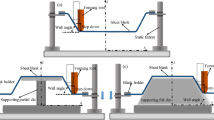Abstract
This paper proposes a new level of understanding of two-point incremental forming (TPIF) with partial die by means of a combined theoretical and experimental investigation. The theoretical developments include an innovative extension of the analytical model for rotational symmetric single point incremental forming (SPIF), originally developed by the authors, to address the influence of the major operating parameters of TPIF and to successfully explain the differences in formability between SPIF and TPIF. The experimental work comprised the mechanical characterization of the material and the determination of its formability limits at necking and fracture by means of circle grid analysis and benchmark incremental sheet forming tests. Results show the adequacy of the proposed analytical model to handle the deformation mechanics of SPIF and TPIF with partial die and demonstrate that neck formation is suppressed in TPIF, so that traditional forming limit curves are inapplicable to describe failure and must be replaced by fracture forming limits derived from ductile damage mechanics. The overall geometric accuracy of sheet metal parts produced by TPIF with partial die is found to be better than that of parts fabricated by SPIF due to smaller elastic recovery upon unloading.








Similar content being viewed by others
References
J. Jeswiet, F. Micari, G. Hirt, A. Bramley, J. Duflou, and J. Allwood, Asymmetric Single Point Incremental Forming of Sheet Metal, Ann. CIRP, 2005, 54, p 623–650
K. Jackson and J. Allwood, The Mechanics of Incremental Sheet Forming, J. Mater. Process. Technol., 2009, 209, p 1158–1174
P.A.F. Martins, N. Bay, M. Skjoedt, and M.B. Silva, Theory of single point incremental forming, Ann. CIRP, 2008, 57, p 247–252
S. Matsubara, A Computer Numerically Controlled Dieless Incremental Forming of a Sheet Metal, J. Eng. Manuf., 2001, 215, p 959–966
A. Attanasio, E. Ceretti, C. Giardini, and L. Mazzoni, Asymmetric Two Points Incremental Forming: Improving Surface Quality and Geometric Accuracy by Tool Path Optimization, J. Mater. Process. Technol., 2008, 197, p 59–67
J. Jeswiet, J.R. Duflou, and A. Szekeres, Forces in Single Point and Two Point Incremental Forming, Adv. Mater. Res., 2005, 6–8, p 449–456
G. Hirt, J. Ames, and M. Bambach, Basic Investigation into the Characteristics of Dies and Support Tools Used in CNC-Incremental Sheet Forming, Proceedings of the International Deep Drawing Research Group Conference, IDDRG, Porto, Portugal, 2006, p 341–348
M.B. Silva, M. Skjoedt, P.A.F. Martins, and N. Bay, Revisiting the Fundamentals of Single Point Incremental Forming by Means of Membrane Analysis, Int. J. Mach. Tools Manuf, 2008, 48, p 73–83
A.G. Atkins, Fracture in Forming, J. Mater. Process. Technol., 1996, 56, p 609–618
ASTM Standard E8/E8M, 2011, Standard Test Methods for Tension Testing of Metallic Materials, ASTM International, West Conshohocken, PA, 2011. doi:10.1520/E0008_E0008M-11.
M. Skjoedt, M.B. Silva, P.A.F. Martins, and N. Bay, Strategies and Limits in Multi-stage Single-Point Incremental Forming, J. Strain Anal. Eng. Des., 2010, 45, p 33–44
A.G. Atkins, Fracture Mechanics and Metal Forming: Damage Mechanics and the Local Approach of Yesterday and Today, Fracture Research in Retrospect, H.P. Rossmanith, Ed., A.A. Balkema, Rotterdam, 1997, p 327–350.
M. Durante, A. Formisano, and A. Langella, Observations on the Influence of Tool-Sheet Contact Conditions on an Incremental Forming Process, J. Mater. Eng. Perform., 2011, 20, p 941–946
G. Hussain and L. Gao, A novel Method to Test the Thinning Limits of Sheet Metals in Negative Incremental Forming, Int. J. Mach. Tools Manuf., 2007, 47, p 419–435
Acknowledgments
The work of MSc. Tiago Martinho and MSc. Valter Robalo during the research work is greatly acknowledged.
Author information
Authors and Affiliations
Corresponding author
Rights and permissions
About this article
Cite this article
Silva, M.B., Martins, P.A.F. Two-Point Incremental Forming with Partial Die: Theory and Experimentation. J. of Materi Eng and Perform 22, 1018–1027 (2013). https://doi.org/10.1007/s11665-012-0400-3
Received:
Revised:
Published:
Issue Date:
DOI: https://doi.org/10.1007/s11665-012-0400-3



